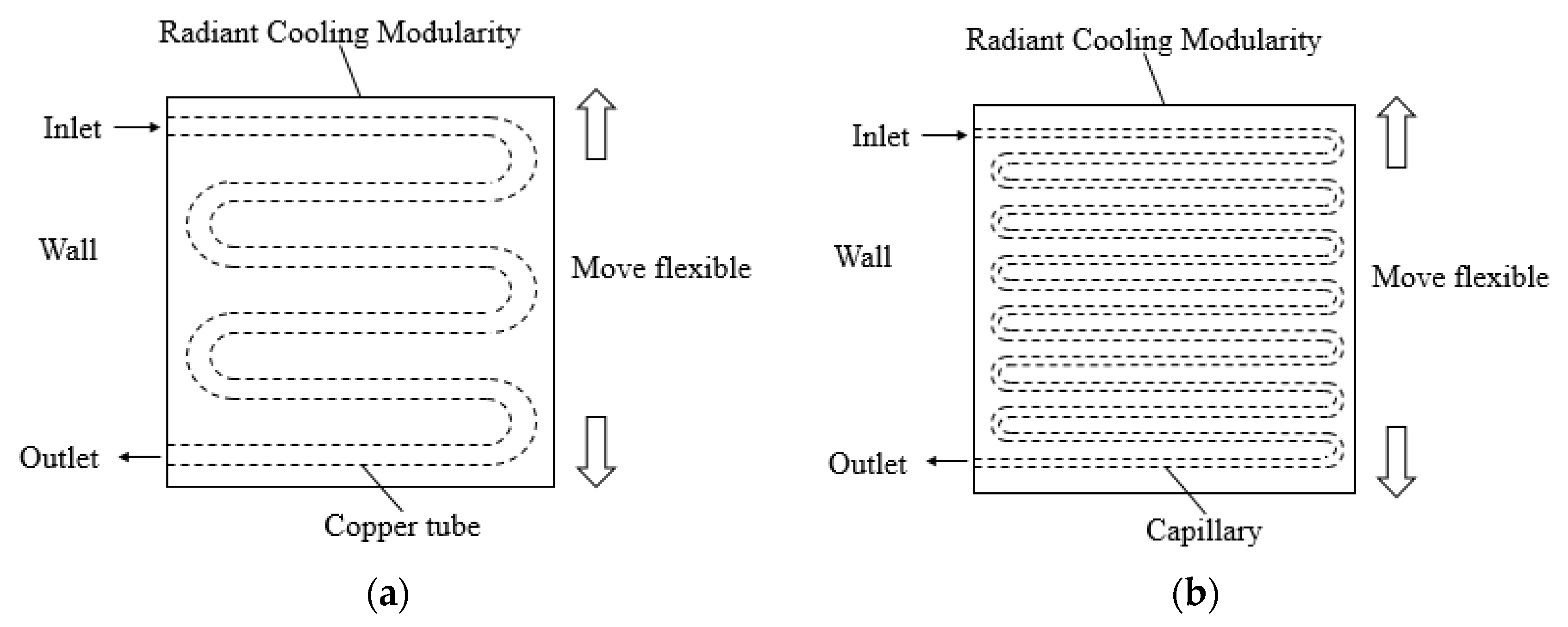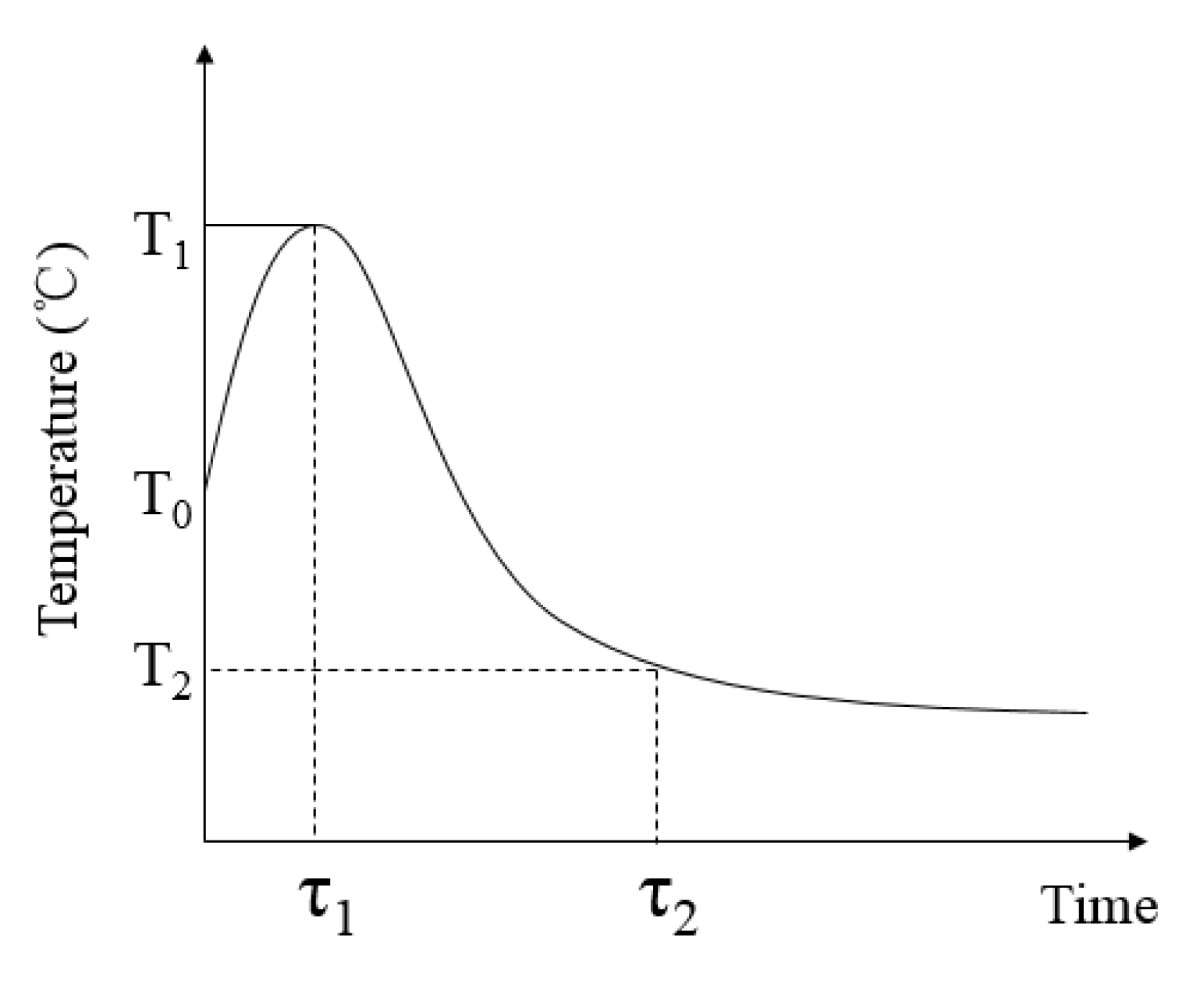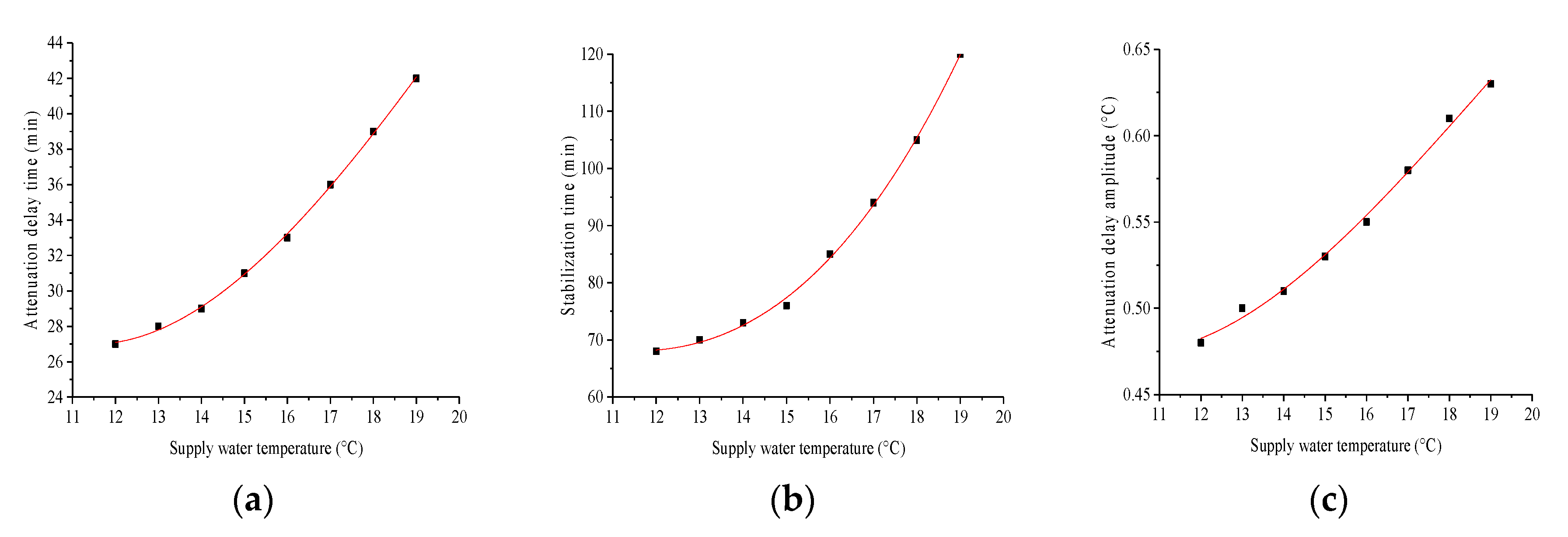Experimental Study on Thermal Response Characteristics of Indoor Environment with Modular Radiant Cooling System
Abstract
1. Introduction
2. Experimental Description
2.1. Structure of Modular Radiant Terminal
2.2. Brief of the Experiment System
2.3. Experimental Test Procedure
2.4. Date Analyzing Method
3. Results and Discussion
3.1. Effect of Supply Water Temperature on Indoor Thermal Environment
3.1.1. Temperature Distribution of Envelope
3.1.2. Temperature Distribution of Indoor Air
3.2. Thermal Response Characteristics of Envelope
3.2.1. Thermal Response Characteristics of Envelope with CTRC System
3.2.2. Thermal Response Characteristics of Envelope with CRC System
3.3. Thermal Response Characteristics of Indoor Air
3.3.1. Thermal Response Characteristics of Indoor Air with CTRC System
3.3.2. Thermal Response Characteristics of Indoor Air with CRC System
4. Conclusions
Author Contributions
Funding
Conflicts of Interest
References
- Fang, H.; Xia, J.; Jiang, Y. Key issues and solutions in a district heating system using low-grade industrial waste heat. Energy 2015, 86, 589–602. [Google Scholar] [CrossRef]
- Alalouch, C.; Al-Saadi, S.N.; AlWaer, H.; Al-Khaled, K. Energy saving potential for residential buildings in hot climates: The case of Oman. Sustain. Cities Soc. 2019, 46, 101442. [Google Scholar] [CrossRef]
- Li, Z.; Zhang, D.; Chen, X.; Li, C. A comparative study on energy saving and economic efficiency of different cooling terminals based on exergy analysis. J. Build. Eng. 2020, 30, 101224. [Google Scholar] [CrossRef]
- Rhee, K.N.; Kim, K.W. A 50 year review of basic and applied research in radiant heating and cooling systems for the built environment. Build. Environ. 2015, 91, 166–190. [Google Scholar] [CrossRef]
- Rhee, K.N.; Olesen, B.W.; Kim, K.W. Ten questions about radiant heating and cooling systems. Build. Environ. 2017, 112, 367–381. [Google Scholar] [CrossRef]
- Song, D.; Kim, T.; Song, S.; Hwang, S.; Leigh, S.-B. Performance evaluation of a radiant floor cooling system integrated with dehumidified ventilation. Appl. Therm. Eng. 2008, 28, 1299–1311. [Google Scholar] [CrossRef]
- Romaní, J.; De Gracia, A.; Cabeza, L.F. Simulation and control of thermally activated building systems (TABS). Energy Build. 2016, 127, 22–42. [Google Scholar] [CrossRef]
- Qin, F.; Wang, C.; Feng, L.; Lv, H. Modeling Based on Semi-tensor Product for Radiant Floor Cooling Systems. Procedia Eng. 2017, 205, 3782–3788. [Google Scholar] [CrossRef]
- Zakula, T.; Armstrong, P.R.; Norford, L. Advanced cooling technology with thermally activated building surfaces and model predictive control. Energy Build. 2015, 86, 640–650. [Google Scholar] [CrossRef]
- Ferkl, L.; Široký, J. Ceiling radiant cooling: Comparison of ARMAX and subspace identification modelling methods. Build. Environ. 2010, 45, 205–212. [Google Scholar] [CrossRef]
- Arteconi, A.; Costola, D.; Hoes, P.-J.; Hensen, J. Analysis of control strategies for thermally activated building systems under demand side management mechanisms. Energy Build. 2014, 80, 384–393. [Google Scholar] [CrossRef]
- Lehmann, B.; Dorer, V.; Gwerder, M.; Renggli, F.; Todtli, J. Thermally activated building systems (TABS): Energy efficiency as a function of control strategy, hydronic circuit topology and (cold) generation system. Appl. Energy 2011, 88, 180–191. [Google Scholar] [CrossRef]
- Gwerder, M.; Lehmann, B.; Todtli, J.; Dorer, V.; Renggli, F. Control of thermally-activated building systems (TABS). Appl. Energy 2008, 85, 565–581. [Google Scholar] [CrossRef]
- Olesen, B.W.; Sommer, K.; Düchting, B. Control of Slab Heating and Cooling Systems Studied by Dynamic Computer Simulations. Ashrae Trans. 2002, 108, 698–707. [Google Scholar]
- Yin, Y.; Wang, R.; Zhai, X.; Ishugah, T. Experimental investigation on the heat transfer performance and water condensation phenomenon of radiant cooling panels. Build. Environ. 2014, 71, 15–23. [Google Scholar] [CrossRef]
- Novoselac, A.; Srebric, J. A critical review on the performance and design of combined cooled ceiling and displacement ventilation systems. Energy Build. 2002, 34, 497–509. [Google Scholar] [CrossRef]
- Kim, K.W.; Olesen, B.W. Radiant Heating & Cooling Systems: Part 2. Ashrae J. 2015, 57, 28–37. [Google Scholar]
- Ryu, S.; Lim, J.-H.; Yeo, M.-S.; Kim, K.-W. A Study on the Control Methods for Radiant Floor Heating and Cooling System in Residential Building. ASHRAE Trans. 2004, 110, 106–116. [Google Scholar]
- Cho, S.-H.; Zaheer-Uddin, M. An experimental study of multiple parameter switching control for radiant floor heating systems. Energy 1999, 24, 433–444. [Google Scholar] [CrossRef]
- Lim, J.-H.; Jo, J.-H.; Kim, Y.-Y.; Yeo, M.-S.; Kim, K.-W. Application of the control methods for radiant floor cooling system in residential buildings. Build. Environ. 2006, 41, 60–73. [Google Scholar] [CrossRef]
- Rhee, K.; Ryu, S.; Yeo, M.; Kim, K. Simulation study on hydronic balancing to improve individual room control for radiant floor heating system. Build. Serv. Eng. Res. Technol. 2010, 31, 57–73. [Google Scholar] [CrossRef]
- Olesen, B.W. Radiant floor heating in theory and practice. Ashrae J. 2002, 44, 19–26. [Google Scholar]
- Zhao, K.; Liu, X.-H.; Jiang, Y. On-site measured performance of a radiant floor cooling/heating system in Xi’an Xianyang International Airport. Sol. Energy 2014, 108, 274–286. [Google Scholar] [CrossRef]
- Lehmann, B.; Dorer, V.; Koschenz, M. Application range of thermally activated building systems tabs. Energy Build. 2007, 39, 593–598. [Google Scholar] [CrossRef]
- Xie, D.; Wang, Y.; Wang, H.; Mo, S.; Liao, M. Numerical analysis of temperature non-uniformity and cooling capacity for capillary ceiling radiant cooling panel. Renew. Energy 2016, 87, 1154–1161. [Google Scholar] [CrossRef]
- Feng, J.; Schiavon, S.; Bauman, F. New method for the design of radiant floor cooling systems with solar radiation. Energy Build. 2016, 125, 9–18. [Google Scholar] [CrossRef]
- Seo, J.-M.; Song, D.; Lee, K.H. Possibility of coupling outdoor air cooling and radiant floor cooling under hot and humid climate conditions. Energy Build. 2014, 81, 219–226. [Google Scholar] [CrossRef]
- Chiang, W.-H.; Wang, C.-Y.; Huang, J.-S. Evaluation of cooling ceiling and mechanical ventilation systems on thermal comfort using CFD study in an office for subtropical region. Build. Environ. 2012, 48, 113–127. [Google Scholar] [CrossRef]
- Le Dréau, J.; Heiselberg, P. Sensitivity analysis of the thermal performance of radiant and convective terminals for cooling buildings. Energy Build. 2014, 82, 482–491. [Google Scholar] [CrossRef]
- Ministry of Housing and Urban-Rural Development of PR China. Technical Standard for Nearly Zero Energy Buildings; China Architecture & Building Press: Beijing, China, 2019.
- ISO. ISO 7730—Ergonomics of the Thermal Environment-Analytical Determination and Interpretation of Thermal Comfort Using Calculation of the PMV and PPD Indices and Local Thermal Comfort Criteria; International Standard Organization: Geneva, Switzerland, 2005. [Google Scholar]










| Case | Terminal Type | Operation Schedule | Supply Water Temperature (°C) |
|---|---|---|---|
| 1 | Copper tube/Capillary | 08:00–12:00 | 12 |
| 2 | Copper tube/Capillary | 08:00–12:00 | 13 |
| 3 | Copper tube/Capillary | 08:00–12:00 | 14 |
| 4 | Copper tube/Capillary | 08:00–12:00 | 15 |
| 5 | Copper tube/Capillary | 08:00–12:00 | 16 |
| 6 | Copper tube/Capillary | 08:00–12:00 | 17 |
| 7 | Copper tube/Capillary | 08:00–12:00 | 18 |
| 8 | Copper tube/Capillary | 08:00–12:00 | 19 |
© 2020 by the authors. Licensee MDPI, Basel, Switzerland. This article is an open access article distributed under the terms and conditions of the Creative Commons Attribution (CC BY) license (http://creativecommons.org/licenses/by/4.0/).
Share and Cite
Li, Z.; Zhang, D.; Li, C. Experimental Study on Thermal Response Characteristics of Indoor Environment with Modular Radiant Cooling System. Energies 2020, 13, 5012. https://doi.org/10.3390/en13195012
Li Z, Zhang D, Li C. Experimental Study on Thermal Response Characteristics of Indoor Environment with Modular Radiant Cooling System. Energies. 2020; 13(19):5012. https://doi.org/10.3390/en13195012
Chicago/Turabian StyleLi, Zhengrong, Dongkai Zhang, and Cui Li. 2020. "Experimental Study on Thermal Response Characteristics of Indoor Environment with Modular Radiant Cooling System" Energies 13, no. 19: 5012. https://doi.org/10.3390/en13195012
APA StyleLi, Z., Zhang, D., & Li, C. (2020). Experimental Study on Thermal Response Characteristics of Indoor Environment with Modular Radiant Cooling System. Energies, 13(19), 5012. https://doi.org/10.3390/en13195012




